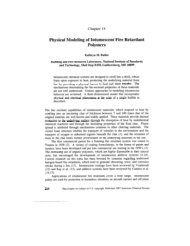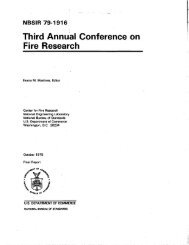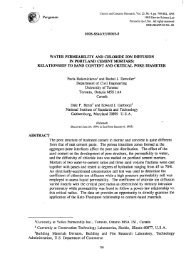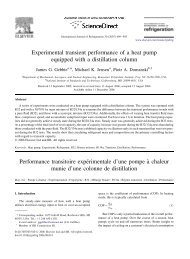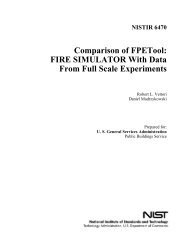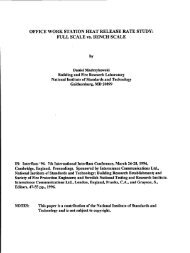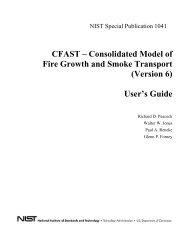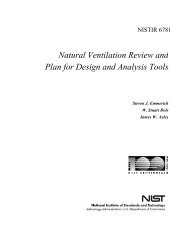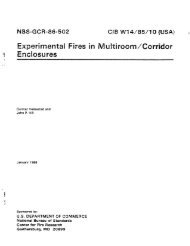Study of Technology for Detecting Pre-Ignition Conditions of ... - NIST
Study of Technology for Detecting Pre-Ignition Conditions of ... - NIST
Study of Technology for Detecting Pre-Ignition Conditions of ... - NIST
Create successful ePaper yourself
Turn your PDF publications into a flip-book with our unique Google optimized e-Paper software.
.<br />
. .<br />
.<br />
“-<br />
1.0 Introduction<br />
CPSC-IAG95-1145<br />
In 1994, 3,425 deaths, 19,475 injuries, and $4.2 billion in property damage were caused<br />
by 438,000 home fires in the United States. 1 Through. analysis .<strong>of</strong> the 1988-1992 data collected<br />
through the National Fire Incident Reporting System, NFIRS, the National Fire Protection<br />
Association estimated that in that period, range/oven appliance fires averaged about 20 % <strong>of</strong> all<br />
home fires and were responsible <strong>for</strong> approximately 20 YO <strong>of</strong> the injuries, 5 % <strong>of</strong> the deaths, and<br />
5 YO <strong>of</strong> the property 10SS associated with home fires. A majotity <strong>of</strong> these range/oven fires<br />
involved food.z Currently, there is not an adequate understanding <strong>of</strong> the pre-ignition conditions<br />
<strong>of</strong> food fires that might be monitored to indicate an incipient fire nor <strong>of</strong> the devices that might<br />
be used to detect and act upon such conditions. The overall objective <strong>of</strong> this project is to identify<br />
pre-ignition conditions and the methods, materials, and devices that can be used to detect such<br />
conditions and alert, or intervene, to reduce the risk <strong>of</strong> cooking-related fires associated with<br />
electric and gas range:} and cooktops.<br />
This objective was addressed through two major activities in Phase I. In order to identify<br />
the pre-ignition conditions, experiments were per<strong>for</strong>med to monitor specific aspects <strong>of</strong> the<br />
environment and how they changed as ignition conditions were approached during heating <strong>of</strong><br />
various foods using combinations <strong>of</strong> range types and range-hood status (active/inactive).<br />
Temperatures <strong>of</strong> the surroundings close to the pan as well as plume velocity and laser-attenuation<br />
measurements were recorded. A Fourier trans<strong>for</strong>m infrared, FT~ spectrometer was used to<br />
determine if the prochxtion <strong>of</strong> any specific gas species was significant. Analysis <strong>of</strong> the<br />
experimental results his determined the conditions with potential, alone or in combination with<br />
one another, to provide input to a pre-ignition sensor.<br />
The second activity was the identification <strong>of</strong> methods, materials, and devices with<br />
potential as means <strong>of</strong> detection and reaction to pre-ignition conditions. This was begun with a<br />
literature and patent search. The search focused on sensing devices and technologies capable <strong>of</strong><br />
detecting one or more cooking-related conditions as well as control technologies capable <strong>of</strong><br />
shutting <strong>of</strong>f gas and electric ranges in the event <strong>of</strong> a detected threat. The bibliographical<br />
in<strong>for</strong>mation on technologies related to these goals is provided with comments regarding their<br />
potential usefulness in a range pre-ignition detection system.<br />
2.0 Experimental<br />
2.1 General Design<br />
The focus <strong>of</strong> this set <strong>of</strong> experiments was to characterize the environment immediately<br />
preceding ignition. Combinations <strong>of</strong> food type and cooking pan were chosen primarily to<br />
investigate cases in which the food can ignite after a relatively short time <strong>of</strong> heating and likely<br />
result in a serious fire hazard. High heating levels were chosen in order to ensure ignition, which<br />
at low or medium settings might not occur at all or might require hours.<br />
Three variables were changed in order to establish their effects on the pre-ignition<br />
environment: (1) fwd type, (2) range style, and (3) hood operation. Different fbods were studied<br />
1



